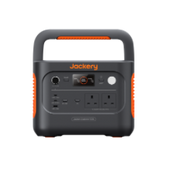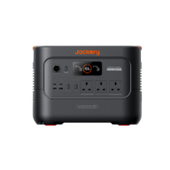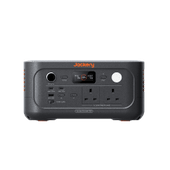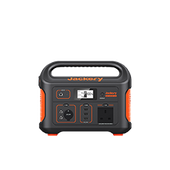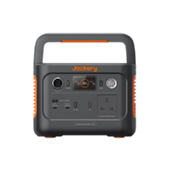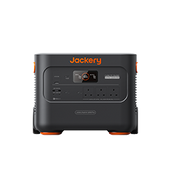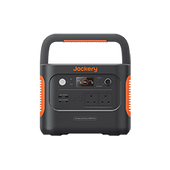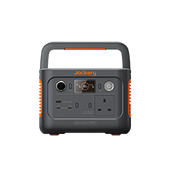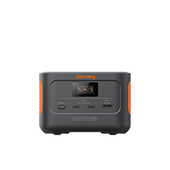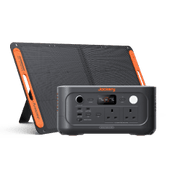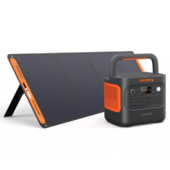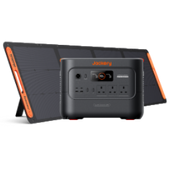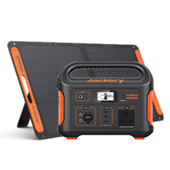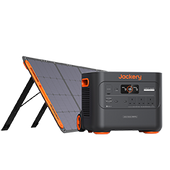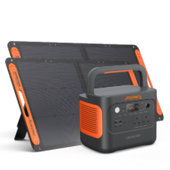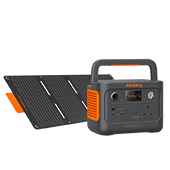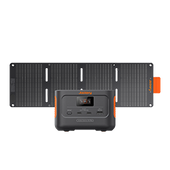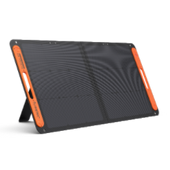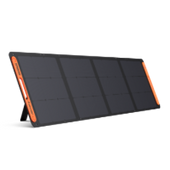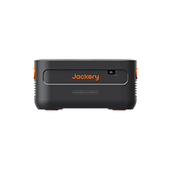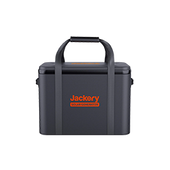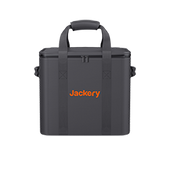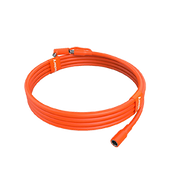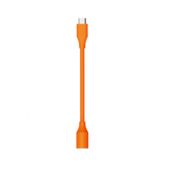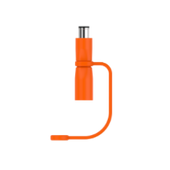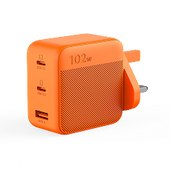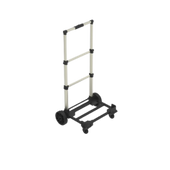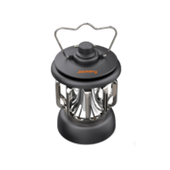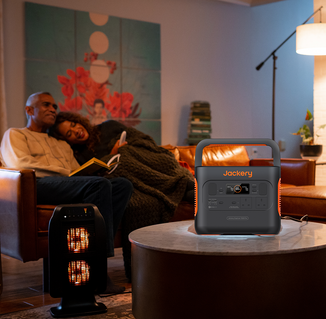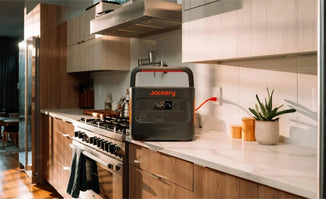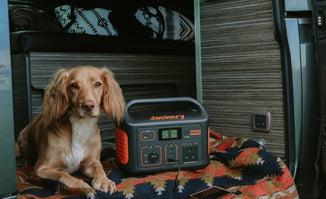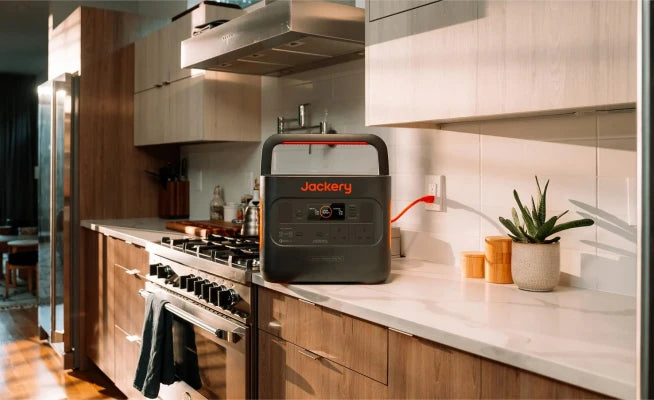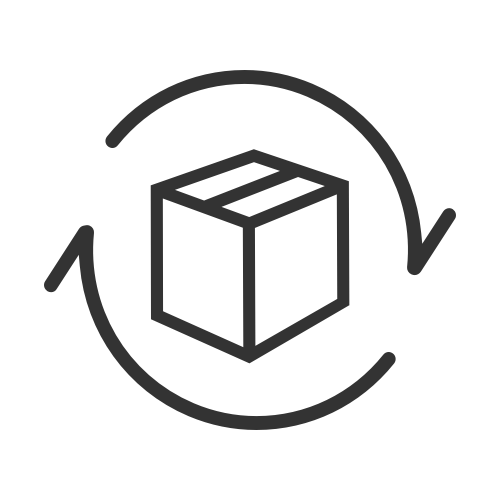A 1000W inverter is suitable for home emergency backup power, outdoor camping, or mobile office use. The rated power of a 1000W inverter is the maximum power it can provide (1000W), which means that the power it can consume at any given time is 1000W. For example, during a power outage, you can use a 1000W inverter to support the operation of some small appliances and lighting equipment, such as light bulbs, TVs, laptops, etc.
We highly recommend Jackery Explorer 1000 v2 and 1000 Plus, the best 1000W portable power stations with pure sine wave inverters, to ensure stable and consistent power supplies for your home or outdoor activities.
|
Key Takeaways: |
|
- A 1000W inverter can continuously provide up to 1000 power to connected devices. - A 1000W inverter can run a 60W laptop computer, a 150W LED TV, and a 500W blender simultaneously. - Whether a 1000W inverter is sufficient depends on your load power requirements, input power matching, and your needs for size and portability. - A high-quality 1000W inverter is usually a pure sine wave inverter with a more than 85% conversion rate, protection functions, and a 3-5 year warranty service. - A 1000W inverter must choose a lithium battery of at least 48V and 150Ah. |
What Is a 1000W Inverter?
An inverter is a device that converts direct current (DC) into alternating current (AC). When camping and travelling, the inverter converts the power of a 12-volt (V) leisure battery into a device that can run electronic devices and appliances using a 230V socket within the system's capacity. A 1000W inverter means that its rated output power is 1000W. It can continuously provide up to 1000 watts of power to connected devices.
Main Components and Functions of a 1000W Inverter
The inverter mainly comprises three parts: an inverter bridge, a control unit, and a filter circuit.
Inverter Bridge: This is the core component of the inverter and consists of multiple switching elements (such as IGBTs). It converts DC power into high-frequency phased AC power by controlling the switching elements' on-and-off.
Control Unit: It realises intelligent control of the inverter through a microprocessor or a digital signal processor (DSP), including PWM waveform generation, protection logic processing, etc.
Filter Circuit: The filter circuit usually comprises inductors, capacitors, and other components. It filters out high-frequency harmonics in AC power to make the output waveform smoother and more stable.
How Does a 1000W Inverter Work?
The inverter's working principle is mainly based on power electronics and pulse width modulation (PWM) technology. It uses the switching characteristics of semiconductor devices (such as field effect tubes, thyristors, IGBTs or MOSFETs, etc.) to control the power supply voltage and current through rapid switching, thereby converting DC power into AC power of corresponding frequency and voltage. The following are several basic working processes of a 1000W inverter.
Step 1: DC Power Input
The inverter usually accepts 12V, 24V or 48V DC power input (commonly 12V car batteries or special battery packs), and the input power must meet the 1000W output requirements.
Step 2: Rectification and Conversion
The rectifier processes the input DC power and enters the inverter bridge part. In the inverter bridge, the DC power is converted into high-frequency phased AC power by controlling the on and off of the switching elements.
Step 3: Waveform Modulation
Using PWM technology, the phased AC power is modulated into a sine wave or square wave of a specific frequency so that its waveform is close to the AC power of the mains.
Step 4: Filtering and Output
The modulated AC power passes through the filter circuit to filter out high-frequency harmonics and obtain a smooth AC output.
Step 5: Protection and Control
A protection system inside the inverter ensures it can operate stably under load changes or faults and protect the inverter and connected electrical equipment.

What Devices Can the 1000W Inverter Power?
Although a 1000W inverter is challenging to use with high-surge devices such as standard refrigerators, it is very suitable for powering small entertainment and lighting equipment. However, whether a 1000W inverter can provide power depends on the appliances' and equipment's continuous operating control. The following are typical applications of 1000W inverters in various user scenarios:
Electronic and Office Equipment
A 1000W inverter can power devices with lower power requirements, such as laptops, smartphones, tablets, and cameras. Entertainment equipment, such as TVs, game consoles, DVD players, and sound systems, is also within the inverter's operating range.
The following table shows the electronic and office equipment that can be operated with a 1000W inverter (for reference only):
|
Types of Electronic and Office Equipment |
Watts (W) |
|
Mobile Phone |
10-20W |
|
Tablet Computer |
10-20W |
|
Laptop Computer |
20-60W |
|
Monitor |
50-100W |
|
Printer |
50-100W |
|
LED TV |
50-150W |
|
Game Console |
100-200W |
|
Desktop Computer |
200-300W |
Kitchen Appliances
A 1000W inverter can power small kitchen appliances, including coffee machines and blenders. Although the operating power of appliances such as refrigerators and ovens is not high, the starting power usually exceeds the 1000W rated power. For example, an electric kettle with a starting power of about 1000W can be used briefly to avoid long-term full-load operation.
The following table shows the kitchen appliances that can be operated with a 1000W inverter (for reference only):
|
Types of Electronic and Office Equipment |
Watts (W) |
|
Blender |
300-700W |
|
Microwave Oven (small) |
600-800W |
|
Coffee Machine |
600-800W |
|
Toaster |
800-1500W |
Household Appliances
A 1000W inverter can power some household appliances, including lighting and low-power appliances. Pay attention to the matching of load type and power.
For example, a 1000W inverter can provide long-term and stable operation for household appliances such as LED lights and energy-saving lamps with a low starting current. As long as the total power is controlled within 1000W, you can even run LED lights, electric shavers and fans simultaneously.
The following table shows the household appliances that can be operated with a 1000W inverter (for reference only):
|
Types of Electronic and Office Equipment |
Watts (W) |
|
Electric Shaver |
5-15W |
|
LED Lamp |
5- 20W (per bulb) |
|
Electric Fan |
50-100W |
|
Vacuum Cleaner (handheld) |
200-500W |
|
Hair Dryer |
800-1800W |

Outdoor Equipment
A 1000W inverter can continuously output 1000W power, providing stable power support for most outdoor equipment. It can also meet the power supply needs of tools such as camping lights with low power requirements.
Please prioritise low-power outdoor equipment and use equipment such as electric kettles with a rated power of about 1000W in a time-sharing manner. The following table shows the outdoor equipment that can be operated with a 1000W inverter (for reference only):
|
Types of Electronic and Office Equipment |
Watts (W) |
|
LED Camping Lights |
5-20W |
|
Portable Refrigerators |
50-200W |
|
Projectors |
100-300W |
|
Small Water Pumps |
200-500W |
Power Tools
1000W inverters are suitable for powering small and medium-power power tools. Handheld power tools such as electric drills, electric screwdrivers, grinders, angle grinders, and small cutters have low starting currents, and their continuous operating power is within the range of the 1000W inverter. By correctly matching the load, a 1000W inverter can meet the power supply needs of outdoor operations and emergency repairs.
The following table shows the power tools that can be operated with a 1000W inverter (for reference only):
|
Types of Electronic and Office Equipment |
Watts (W) |
|
Power Screwdriver |
200W |
|
Sand Grinder |
200-500W |
|
Jig Saw |
300-600W |
|
Drill |
300-700W |
How to Determine If a 1000W Inverter Is Enough for You?
People often ask if a 1000W inverter is enough for daily use. In the following content, we will examine this question in depth to help you determine whether it is.

Load Power Requirements
You must determine your power requirements, which depend on the devices you want to power through the inverter. For example, if you plan to power a laptop and a few LED lights, then a 1000W inverter may be enough.
Here are the steps to calculate the load power required to run your appliances:
Step 1: Calculate Total Load Power
Please list all the devices that need to be powered simultaneously (such as refrigerators, lights, computers, etc.), check their rated power (W) and add them up. Most devices and appliances have rated power on the back or bottom label. You can also search the device model on the brand website to get its wattage information.
Example: If you need to run five LED bulbs (20W*5), an LED TV (150W), and a laptop computer (60W) simultaneously, the total operating power is 310W. A 1000W inverter can run appliances with a total power of 310W simultaneously.
Step 2: Consider the Starting Power
When starting, motor-type equipment such as air conditioners and water pumps may have 3-7 times the instantaneous power (surge power). For example, the starting power of a 1000W air conditioner may be as high as 7000W. So, you need to confirm whether the inverter's peak power is sufficient. For example, a 1000W inverter may have a peak power of 2000W, but it cannot run an air conditioner with a starting power of 7000W.
Input Power Matching
You must confirm whether the inverter's input voltage range (12V/24V/48V DC) matches your storage battery system. For example, if the 1000W inverter has a 12V input, it must provide at least 83A (1000W ÷ 12V) of current. The wire thickness is recommended to be 6mm² or above.
Currently, the 1000W inverter's battery capacity requirements are also high. For example, a 24V 100Ah lithium battery (80% discharge depth) can theoretically support a 1000W load for about 2 hours.
Size and Installation Conditions
If you need a portable inverter for a vehicle, size and portability become essential considerations. A 1000W inverter is usually 30×15×10cm in size, relatively compact and lightweight. It is suitable for vehicle or home emergency use, but you need to confirm whether the installation space is sufficient, especially considering the heat dissipation requirements. For example, if you install a 1000W inverter in a small car trunk, you must choose a model with a good heat dissipation design.
In short, whether a 1000W inverter is enough depends on your load power requirements, input power matching, and your needs for size and portability. If you want to use it as a short-term emergency power supply, a 1000W inverter may be enough. But if you want to use it for long-term off-grid life, it is not enough, and you need to consider a higher-power inverter or a parallel system.
Best 1000W Jackery Portable Power Stations with Inverters
Jackery is a global solar products manufacturer that produces high-quality solar generators, portable power stations, and solar panels. We diligently strive to facilitate access to solar solutions for outdoor enthusiasts and individuals seeking preparedness for unforeseen power outages. Two 1000W portable power stations are recommended: Jackery Explorer 1000 v2 and 1000 Plus, which provide stable and consistent power supplies with pure sine wave inverters.
Jackery Explorer 1000 v2 Portable Power Station
The Jackery Explorer 1000 v2 Portable Power Station is a battery-powered station with a significant capacity of 1070Wh. It uses the pure sine wave inverter to produce an AC waveform that closely mimics the smooth, consistent power supplied by the utility grid. This clean power ensures that your devices operate as designed, without the risk of damage or malfunction caused by the irregular waveforms of modified sine wave inverters.
The power station is recognised as a more compact, lightweight, and economical charging solution compared to comparable items on the market. It features a collapsable handle and an ergonomic design, facilitating more straightforward transport to outdoor settings.

- Portable Power Supply: The Explorer 1000 v2 Portable Power Station has an excellent 1500W output and 1070Wh capacity, 50% higher than the Explorer 1000. It can power high-demand items like refrigerators, kettles, coffee makers, etc. Equipped with USB-A/C connections and dual PD charging up to 100W, it can simultaneously charge several devices (phone, laptop), rendering it the ideal companion for all your power requirements.
- Fast Charging: The app's Emergency Charge Mode allows the Explorer 1000 v2 Portable Power Station to fully charge in less than an hour, offering vital power backup when the battery runs low. Moreover, charging from 0% to 100% within two hours via an AC wall outlet prolongs battery longevity.
- Quiet Operation: Experience serenity with its nearly silent operation, maintaining noise levels below 22dB while energising your devices. This power station guarantees uninterrupted enjoyment during camping, work, or relaxation so you can power your electric cookers and other electronics without noise.
The following are the running time of using Jackery Explorer 1000 v2:
|
Appliances |
Running Time |
|
For Home Backup |
|
|
TV (60W) |
13.2H |
|
Refrigerator (400W) |
2.1H |
|
Coffee Maker (550W) |
1.6H |
|
Oven (850W) |
1H |
|
Ceiling Fan (200W) |
4.1H |
|
For Outdoor Activities |
|
|
Portable Cooler (200W) |
4.1H |
|
Electric Kettle (600W) |
1.4H |
|
Camping Light (5W) |
43.9H |
|
Blender (300W) |
2.8H |
(*The working hours are only for reference; the actual working hours depend on your usage.)
Jackery Explorer 1000 Plus Portable Power Station
The Explorer 1000 Plus features an impressive 1264Wh durable LiFePO4 battery and a 2000W full-power pure sine wave inverter, supplying sufficient energy for almost all essential devices. Remarkably, it can augment its capacity to 5kWh by incorporating up to three more battery packs.
Many modern electronic devices, especially those with microprocessors, AC motors, or sensitive circuitry, require a pure sine wave to function correctly and efficiently. It includes laptops, computers, medical equipment (like CPAP machines), audio-visual equipment, newer televisions, and specific power tools. Using a modified sine wave inverter with these devices can lead to overheating, reduced lifespan, operational glitches, or even complete failure.

- Expandable Capacity: Employing Jackery's exclusive technology, the Explorer 1000 Plus's capacity can be augmented from 1.26kWh to 5kWh by adding up to three supplementary battery packs. Furthermore, it features a maximum output of 2000W, exceeding the standard 1kWh LFP power plants by 20%. It can charge a camping kettle (750W) for 1.3 hours.
- Ultra Fast Charging: The MPPT technique guarantees 99% efficiency in solar charging. A wall charge from 0% to 100% of the battery requires 100 minutes, while solar charging with four SolarSaga 200W solar panels takes 2 hours. With automobile charging capabilities, you will no longer need to worry about depleting power while outdoors.
- Smart APP Control: Easily manage your Explorer 1000 Plus using WiFi or Bluetooth. It's now easier than ever to monitor remaining battery levels and use the other App functions. Multiple advanced settings can be customised to meet individual requirements, ensuring round-the-clock energy control.
- Safety First: The LiFePO4 battery system is secure and durable, equipped with a proprietary BMS (Battery Management System) that includes integrated protections. After 4,000 charge cycles, the battery retains 70% capacity, guaranteeing a lifespan of 10 years with daily charging. It yields an exceptional cycle life that is eight times longer than that of competitors.
The following are the running time of using Jackery Explorer 1000 Plus:
|
Appliances |
Running Time |
|
For Home Backup |
|
|
TV (60W) |
13.2-66.7H |
|
Refrigerator (400W) |
2.5-10H |
|
Coffee Maker (550W) |
1.8-7.3H |
|
Oven (850W) |
1.2-4.7H |
|
Ceiling Fan (200W) |
4.7-20H |
|
For Outdoor Activities |
|
|
Portable Cooler (200W) |
4.7-20H |
|
Blender (300W) |
3.2-13.3H |
|
Camping Light (5W) |
44.9-800H |
|
Camping Stove (1500W) |
0.7-2.7H |
|
Camping Kettle (600W) |
1.7-6.7H |
(*The working hours are only for reference; the actual working hours depend on your usage.)
How to Choose the Best 1000W Inverter?
When choosing the best 1000W inverter, consider actual needs, efficiency and protection functions, and lamp factors to ensure performance, safety, and long-term reliability.

Factor 1: Inverter Type
If you want to choose the best inverter, you first need to consider whether to choose a pure sine wave inverter or a modified sine wave inverter. Significant differences exist between these two types of inverters regarding output waveform, efficiency, applicable equipment and cost.
Pure Sine Wave Inverter: This inverter has a stable output current and high compatibility and is suitable for precision electronic equipment such as laptops, medical equipment, and air conditioners.
Modified Sine Wave Inverter: A modified sine wave inverter is less expensive, but it may interfere with sensitive equipment and shorten the life of some electrical appliances in long-term use. It is more suitable for essential appliances and equipment, such as light bulbs and electric heaters.
|
|
Pure Sine Wave Inverter |
Modified Sine Wave Inverter |
|
Output Waveform |
Smooth sine wave |
Step waveform |
|
Applicable Equipment |
Precision equipment |
Base equipment |
|
Efficiency |
Low |
High |
|
Electromagnetic Interference |
Low |
High |
|
Price |
High |
Low |
|
Noise |
None |
Low |
|
Lifespan |
Long |
Short |
Factor 2: Efficiency and Conversion Rate
An inverter's efficiency and conversion rate refer to its efficiency in converting direct current into alternating current. A high-efficiency inverter can reduce power consumption and reduce the burden on the battery. Generally, a high-quality inverter's efficiency and conversion rate are above 85%. Almost everyone's best choice is inverters with 90% to 95% efficiency.
Factor 3: Protection Function
High-quality inverters usually have necessary overcurrent protection, short-circuit protection, overtemperature protection, input reverse connection protection, lightning protection, etc. Some high-end inverters even support APP monitoring and fault alarms for real-time management. If the inverter is used outdoors, please pay extra attention to its waterproof and dustproof functions.
Factor 4: Brand and After-Sales Service
Inverters from well-known brands mean reliable product quality and a timely and complete after-sales guarantee. Some brands even provide 3-5 years of warranty service to ensure that users can get timely solutions when there is a problem with the inverter. You can also consider whether some inverter brands provide local repair or replacement services.
1000W Inverter vs. 3000W Inverter
Choosing between a 1000W and a 3000W inverter (or a power station with that inverter capacity) boils down to your power needs. The "wattage" of an inverter directly correlates to how much power it can continuously supply to AC appliances.
1000W Inverter
A 1000W inverter can provide a continuous output of up to 1000 watts of AC power. It typically also has a "surge" rating (e.g., 2000W for a few seconds) to handle the brief power spikes needed to start certain motor-driven appliances.
Ideal for:
Small electronics: Laptops (20-100W), smartphones (10-20W), tablets, cameras.
Basic entertainment: LED TVs (50-150W), game consoles (100-200W), DVD players, sound systems.
Lighting: Multiple LED or CFL bulbs (10-25W each).
Small kitchen appliances: Blenders (300-1000W), toasters (800-1500W), coffee makers (600-1200W - note: some can exceed 1000W, so check specific appliance ratings).
Low-power medical devices: CPAP machines (30-60W), nebulizers.
Small power tools: Drills (500-1000W), electric screwdrivers, small saws.
Camping/Van Life: Powering basic necessities in a tent or small camper.
Limitation:
Cannot power high-demand appliances: Will struggle or fail to run appliances with high continuous wattage or high starting surges, such as full-sized refrigerators, microwaves (many exceed 1000W running), washing machines, space heaters, air conditioners, hair dryers, or large power tools.
3000W Inverter
A 3000W inverter delivers a continuous output of up to 3000 watts of AC power. Like the 1000W, it also has a surge rating, often up to 6000W or 7200W, which is crucial for starting larger motor-driven loads. As we introduced the Jackery Explorer 1000 Plus and 1000 v2, which are use 1000W inverters, whereas, the Jackery Explorer 3000 v2 with 3000W inverter can power 99% of appliances with 3600W continuous power and 7200W surge power.
Ideal for:
Most household appliances: Can comfortably run refrigerators (300-800W running, up to 2200W surge), microwaves (600-1500W), washing machines (1200W running, up to 2300W surge), coffee makers, toasters, blenders.
Larger entertainment systems: Multiple TVs, gaming setups, home theater systems.
Mid-to-large power tools: Circular saws, air compressors, some welders (check specific requirements), larger drills.
RV and Cabin Power: Can power a small RV air conditioner (900-1700W running, up to 2500W surge), small space heaters, and most RV appliances.
Construction Sites: Running multiple tools simultaneously.
Emergency Home Backup: Capable of powering essential circuits in a small to medium-sized home during an outage, including lights, a refrigerator, a freezer, a TV, and possibly a microwave.
How to Choose the Right Battery to Use with a 1000W Inverter?
The 1000W inverter must be used as an off-grid power source with a battery. When choosing a battery suitable for a 1000W inverter, you must consider the battery voltage, capacity, and type.
Step 1: Determine the Battery Voltage
Standard inverter voltages are 12V, 24V, and 48V. The selected battery must match the DC input voltage of the 1000W inverter. Otherwise, it may not work or damage the device. If your inverter voltage is 24V, you must use a 24V battery.
12V Battery: It is suitable for small power inverters (usually ≤1000W). However, it needs to support a continuous current of about 83A (1000W ÷ 12V), which is large and may cause line loss and heating.
24V Battery: It is more suitable for 1000W inverters, and halving the current (about 42A) can reduce line losses.
48V Battery: The first choice for high-power inverters (above 2000W), with lower current (about 21A), the highest efficiency, and suitable for long-term operation.
For 1000W inverters, a 12V battery system is one of the most common choices.
Step 2: Calculate Battery Capacity
To calculate the battery capacity suitable for a 1000W inverter, you must consider load power, usage time, battery voltage, inverter efficiency, and depth of discharge (DoD). The following formula can be used to estimate the battery capacity required for a 1000W inverter.
Capacity (Ah) = Load power (W) × Usage time (h) ÷ Battery voltage (V) ÷ Depth of discharge (DoD) ÷ Inverter efficiency
The following will determine the key parameters used in the formula:
Inverter Rated Power: 1000W
Inverter Load Power: 1000W (assuming entire load operation)
Usage Time: the number of hours required for battery power supply (for example, 5 hours)
Battery Voltage: 24V
Inverter Efficiency: 85%-95% (assuming 90%)
Depth of Discharge (DoD): 80% (lithium battery)
Example: Based on the above formula and key parameters, you can calculate that a 1000W inverter needs to select a lithium battery of at least 48V and 150Ah.
In short, you can adjust the parameters according to actual needs and use the formula to calculate the battery capacity that best matches the inverter.
Step 3: Choose Battery Type
The following is a comparative analysis and recommendations of lead-acid, AGM, lithium-ion (Li-ion) and lithium iron phosphate (LiFePO4) (for reference only):
|
Battery Type |
Lead-Acid Battery |
AGM Battery |
Lithium-ion Battery |
LiFePO4 Battery |
|
Energy Density |
Low |
Moderate |
High |
Moderate |
|
Cycle Life |
300-500 times |
500-800 times |
500-1000 times |
2000-5000 times |
|
Depth of Discharge |
50% |
50%-80% |
80%-90% |
80%-100% |
|
Efficiency |
70%-85% |
80%-85% |
95%+ |
95%+ |
|
Cost |
Low |
Moderate |
High |
High |
|
Maintenance |
Regular water replenishment |
Maintenance-free |
Maintenance-free |
Maintenance-free |
|
Safety |
Acid leakage |
Moderate |
Thermal runaway |
High |
Considering the power requirements of the 1000W inverter, it is recommended that LiFePO4 or lithium-ion batteries with high energy density and long cycle life be prioritised. In addition, people with high performance, life and safety requirements are recommended to choose LiFePO4 batteries. If the budget is limited and the life requirements are not high, you can select lead-acid batteries, but you need to pay attention to regular maintenance. AGM batteries are a better choice if you pursue cost-effectiveness and stability.
1000W Inverters FAQs
The following are the frequently asked questions about the 1000W inverters in the UK.
1. What can run off a 1000W inverter?
A 1000W inverter is ideal for powering small appliances, entertainment equipment, and lighting tools. In short, it can run appliances and devices that consume less than 1000W of power (except for some devices that require too much power to start).
Small appliances: laptops, smartphones, tablets, cameras, LED bulbs
Entertainment systems: TVs, game consoles, DVD players, sound systems
Medical equipment: CPAP machines or nebulisers
Small tools: drills, saws, and small compressors
2. Will a 1000W inverter power a fridge?
Whether a fridge can be run with a 1000W inverter depends on its power requirements. For example, a standard household refrigerator runs 800W but may require more than 1000W power. So, most household refrigerators cannot be run with a 1000W inverter.
However, a 1000W inverter can run a mini fridge with an average operating power of 50- 100W.
3. Can a 1000W inverter run a TV?
Of course, a 1000W inverter is enough to power most modern LED TVs (50- 150W). Today's TVs may consume up to 300W, which is well within the power range of a 1000W inverter.
4. What should I consider when using a 1000W inverter?
When using a 1000W inverter, please pay attention to the following aspects to ensure the stable operation of the equipment and personal safety.
Total load power does not exceed 80%
Correct connection (positive and negative poles)
Well-ventilated location
Away from flammable and explosive items
Final Thoughts
In short, a 1000W inverter enables you to run various home appliances and electronic devices off-grid or during a power outage. Suppose you have a 400W portable refrigerator and a 50W small lighting fixture; a 1000W inverter can fully meet their power needs, allowing you to enjoy iced drinks and night lighting outdoors.
This guide taught you the basic information about 1000W inverters, what devices they can power, and how to choose the best 1000W inverter. Of course, after reading the above, you can also more clearly judge whether a 1000W inverter suits you.

